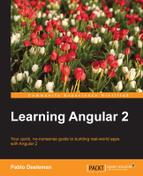In this book, you will find a number of text styles that distinguish between different kinds of information. Here are some examples of these styles and an explanation of their meaning.
Code words in text, database table names, folder names, filenames, file extensions, pathnames, dummy URLs, user input, and Twitter handles are shown as follows: "As a result of this action, we will find a new tsconfig.json file at the root of our project, including the settings required by the TypeScript compiler to transpile the component code into plain ECMAScript 5 JavaScript code readable by current browsers."
A block of code is set as follows:
<body>
<nav class="navbar navbar-default navbar-static-top">
<div class="container">
<div class="navbar-header">
<strong class="navbar-brand">My Pomodoro Timer</strong>
</div>
</div>
</nav>
<pomodoro-timer></pomodoro-timer>
</body>When we wish to draw your attention to a particular part of a code block, the relevant lines or items are set in bold:
<body> <nav class="navbar navbar-default navbar-static-top"> <div class="container"> <div class="navbar-header"> <strong class="navbar-brand">My Pomodoro Timer</strong> </div> </div> </nav> <pomodoro-timer></pomodoro-timer> </body>
Any command-line input or output is written as follows:
$ npm install angular2 es6-shim es6-promise reflect-metadata rxjs zone.js --save
New terms and important words are shown in bold. Words that you see on the screen, for example, in menus or dialog boxes, appear in the text like this: "The learn section gives us access to a quick tutorial to get up to speed with the language in no time."
